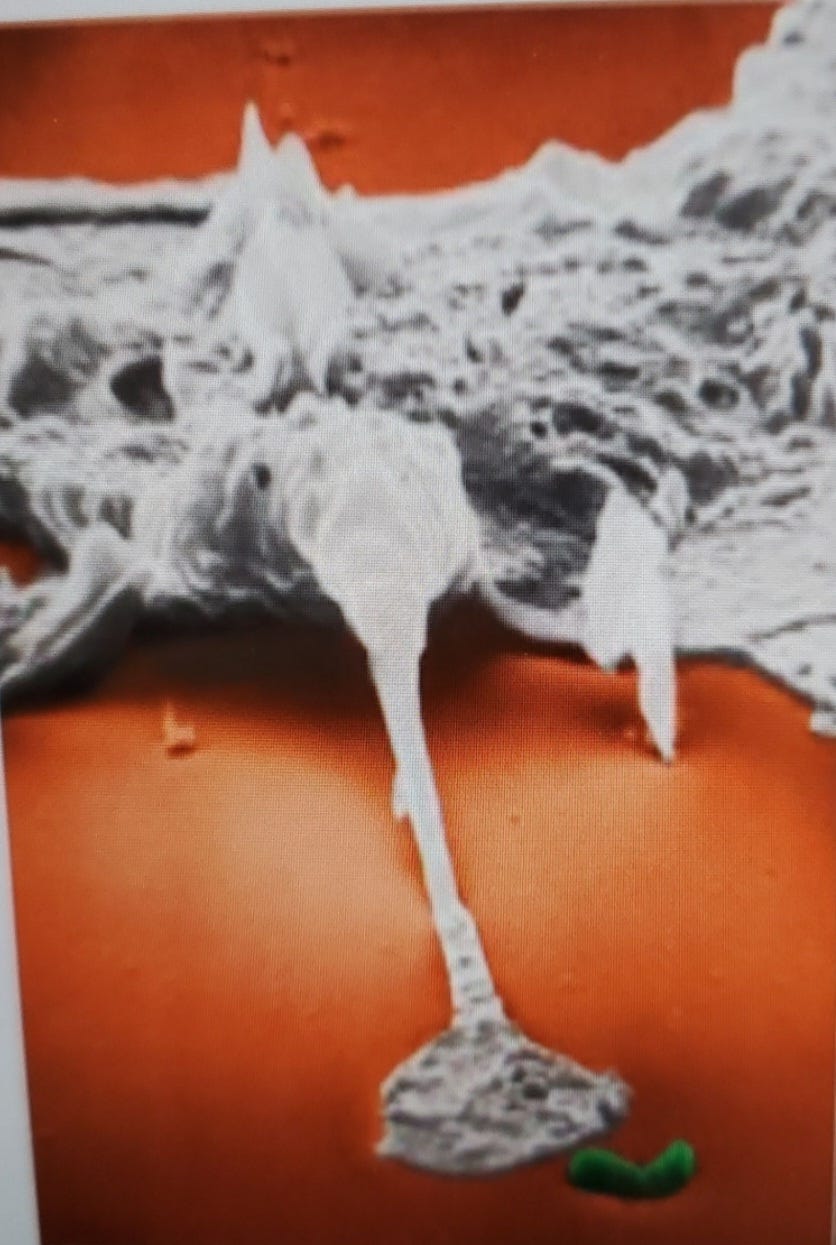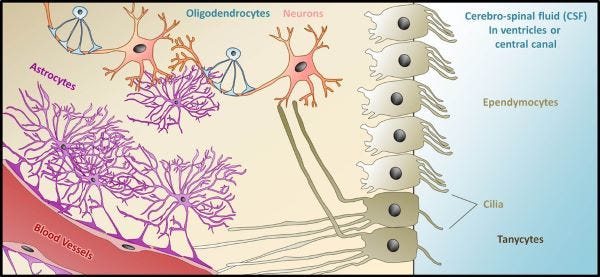Quick disclaimer: This is an educational post about neuroscience and sci-fi, some parts of it can be a little dense, but hopefully I communicated it in a way that isn’t overwhelming. If you want to skip all the science stuff, go to the section labeled ‘The Fiction…’ or come back next week where I apply all the science I talk about here to fiction and write a short story inspired by this informational piece!
Hello friends! For some of you it’s sci-friday. For others it's just Friday! Regardless, today I have some modern day sci-fi for you. I want to give you some fun science-y tools that I think would be awesome for a sci-fi and/or horror story! Last time I did this I discussed Transcranial Magnetic Stimulation. This time, rather than discussing technology, I’m discussing something organic.
Before I get into it, let me divulge my credentials! I am a neuroscientist by trade and am in the process of getting my PhD. That being said, I’m not on Substack to really talk about science typically, but I want to share more about it and I love seeing how actual science can slide its way into science fiction.
Last time I did this, I just posted the concept then let it lie, but this time I want to try and do something a little different. So this week I’ll be explaining this concept, then next week I’ll be applying the concept for myself in and maybe you’ll join me along the way. I’ll be giving myself one week (from Friday to Friday) to write a short story based on this concept as a challenge. I’m hoping others might consider joining in, but I don’t expect you to do it in a week, that’s just for me. So stay tuned for that!
The Science…
With the preamble out of the way, what are we talking about? Today, we’re talking about glia. What are glia? Let’s start with what they’re not: They aren’t neurons. I recently saw someone say that your brain is full of neurons. This is extremely funny because it almost seems right, but your brain isn’t full of neurons. Your brain is neurons… and glia. You see, while you are busy experiencing higher level functioning, moving your body around, thinking, feeling, and experiencing the world through neuronal communication, glia are the supporting cells in your brain that keep your neurons happy and functioning! How do they do that? In so many ways! So let’s talk about these different glia and what they do…
In the brain, glia support neural function, but recent research has found that they actually do much more. Current general knowledge in the field of neuroscience and psychology can be really dismissive of glia’s function in the brain, but they do a lot of amazing stuff. Here’s a list of glia, what they do, and how they help us function everyday…
Astrocytes - Control what chemicals are present in extracellular space. You don’t want neurotransmitters just floating around empty space getting picked up randomly. That could lead to some neurological confusion. I had a professor once call them the caretakers of the brain, but they do much more than that. They’re linked to all sorts of function, including maintaining the blood-brain barrier, addiction formation, maintaining the extracellular space, and more that I don’t have space to get into here.
Schwann cells and Oligodendrocytes - these guys either create or are the myelin that wrap around axons to insulate communication. Schwann cells in the periphery (anywhere that isn’t your brain or spinal cord) make up single myelin sheaths around one axon whereas oligodendrocytes can wrap around multiple axons. I always find these little guys so interesting because they are the equivalent of electrical insulation. There are people in the world who don’t have these fatty cells and that can seriously dampen their ability to think or move. The reason you are able to move and react and think as fast as you can is because your cells are wrapped in these amazing cells that insulate and speed up neuronal communication!
Ependymal cells - Simple enough, these cells insulate ventricles. Ventricles are pockets in your brain that are filled with cerebrospinal fluid (CSF). Ependymal cells do the work of making sure these ventricles are properly insulated and circulate CSF. They also assist in cell migration in early life development. I’ll admit, I don’t find these cells especially interesting, but there are plenty of people out there who probably do fascinating research that would prove me wrong!
Microglia - These little guys are super cool and in my opinion deserve much more attention. Microglia utilize phagocytosis to remove other dead cells. They can also do this with bacteria and viruses that enter the brain making them important for immune response in the brain. Not only this, but they can release inflammatory cytokines into the brain which act as an immune response (astrocytes also do this). There’s also some fascinating research (that I may or may not be doing shhh) that looks at how these cells appear to be overactive when you are stressed or anxious and when these experiences are chronic due to mental illness or developmental disorders, that inflammation can be chronic too! Admittedly the reason for this isn’t entirely clear from what I’ve seen in the field, but it is extremely fascinating.
Okay, so now that we’re past that little crash course, let’s ask a quick question: what is phagocytosis?
Phagocytosis is the process of a cell consuming something and breaking it down. This is common in immune response! It’s how we remove debris from the body as well as harmful bacteria, viruses, and other cells that may have died or are in the process of dying.
Microglia themselves will utilize phagocytosis to remove a large number of things including dysfunctional dying cells, damaged parts of a cell, and in some cases bacteria. There’s a few different ‘signals’ that microglia follow. They follow ‘find-me’ signals as well as ‘eat-me’ signals. These signals are specifically present to guide microglia in keeping the brain clean. Pretty fascinating stuff, right?

The Fiction…
Okay, let’s get out of the weeds for a second and talk about why any of this matters to Sci-Fi. Well, as I said, sometimes when searching for inspiration, we must look within ourselves. It turns out, inside all of us, are some of the most fascinating, creepy, and amazing things constantly functioning to keep us alive. If you ever are in need of great inspiration, skim through an A&P book and you’ll some fascinating stuff!
So let me show you the exact photo that brought me here today:

Pretty amazing, right? That photo is an example of glia tracking down bacteria and preparing to phagocytize it. How cool is that? This little microscopic goliath going after that little bit of bacteria is functioning on a regular basis to keep you alive.
Now let me ask you this: What if that little piece of bacteria was you? What if we were the invasive bacteria where we didn’t belong? What if we triggered the reaction of these glia? What if we were the dying cell that needed to be cleared away from the great cosmic debris?
These were the thoughts that crossed my mind the day I saw this in my Foundations of Neuroscience class in my first year of graduate school. Just imagine that you’re that little speck and that glia saw you as the problem.
There are so many cool possibilities that could come of this concept as a fiction writer. Think about the sorts of ideas that could come of this in a sci-fi setting! My original idea was a War of the Worlds-esque invasion of massive Lovecraftian horrors that devoured people because we were the infection of the Earth that needed to be cleansed.
But then I thought: What about mechanical glia-like automatons being sent to disaster zones to help people or rebuild demolished buildings? Or maybe a species of collectivist bee-like creatures whose specialties within the civilization were similar to that of glia in the brain. Imagine the strange sort of system that could come of that!
That’s why I’m here to tell you about this today. You see, instead of just leaving all this information on your lap, I would like to invite you - my readers and fellow writers - to think of a way to utilize this concept to create your own story! Do some research online, jump into the speculative deep end, do whatever you want, but start with these concepts and see where it lands you! I think this is a fun exercise that I myself am going to be jumping into!
To some of you this may look familiar, and that’s because I shared the beginning’s of this idea during a Macabre Monday note I made in January, and
’s encouragement made me want to try and make it into something more than it was originally!Next week I’m going to share my own story inspired by these fascinating little cells, but for this week I wanted to bring you this concept. I hope to see you sharing your own concepts in the coming weeks or months, or however long it takes you! Sometimes for inspiration, we must look within, and here’s something inside of all of us that could be an amazing sci-fi inspiration.
So, tune in next week for my own glia-inspired story. And for this week, here’s some sources I utilized for this little educational post (also check image captions for more potential sources). I ultimately decided not to put these in APA, but hopefully that’s not an issue for any readers!
Neuroscience: Exploring the brain 4th edition (a great resource, but absurdly expensive, because of course textbooks are)
Lastly, I’m going to tag the Sci-Friday community in this post so that those who expressed interest when I asked a few weeks ago will have easy access to the post…
, , , , , , , , , , , , , , , , , , , , , , , , , , , , , , , , , , , , , , , , , , and







Thank you for taking the time to write all this down! I absolutely love seeing scientific concepts explained with writing in mind, definitely bookmarking your article for later :)
Ooooohhhh…. You have given me a sci-fi idea! I’ll challenge myself with your writing soon.